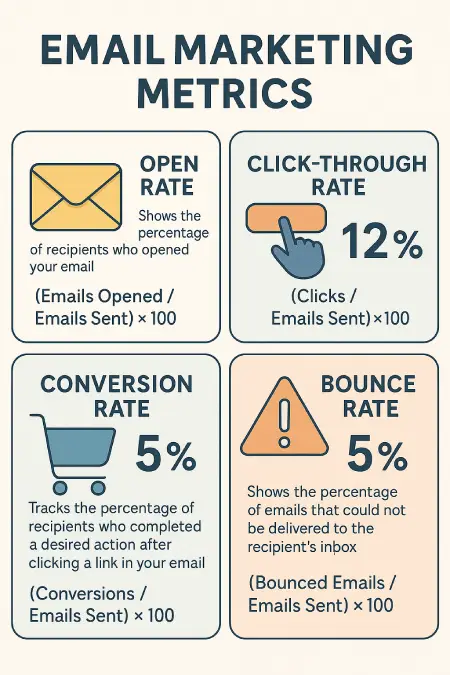Let’s be honest-email marketing often gets pushed to the bottom of the digital to-do list. But here’s the truth: when it’s done well, it still delivers results most channels can’t touch. Why? Because email is personal, permission-based, and incredibly effective—if you’re not treating it like a generic billboard.
The goal isn’t to send more emails. It’s to send smarter ones—emails that feel timely, relevant, and actually helpful. Whether you’re nurturing leads, launching a new product, or just staying in touch, email gives you a direct line to your audience. The trick is knowing how to use it.
Why Email Marketing Dominates the Digital Game in 2025
It’s Budget-Friendly—but Delivers Big
You don’t need a massive ad budget to get email right. No expensive media buys, no fancy production. Just a well-crafted message and a clear purpose. With the right tools, even a small team can reach thousands of people—and make an impact.
For startups and small businesses trying to do more with less, email is the MVP. You’re not renting attention like you do on social platforms. You’re building it.
The ROI Is Ridiculous (In a Good Way)
Some reports say email can return as much as $44 for every $1 spent. Sounds too good to be true—but if you’ve ever run a solid campaign, you know it’s not. Of course, that kind of return doesn’t come from lazy batch-and-blast tactics. It comes from relevance. Targeted, thoughtful, timely emails convert. Period.
It’s Transparent and Trackable
The beauty of email? You know exactly how it’s performing. Open rates, click-throughs, conversions, unsubscribes—it’s all there. You don’t have to guess what’s working. The data tells you. And if you’re paying attention, it can help you sharpen your strategy fast.
How Smart Email Marketing Actually Works
We’ve all seen those templated, robotic emails that make you want to unsubscribe immediately. In 2025, there’s no excuse for that.
Smart email marketing is about relevance. It’s about understanding your audience and crafting content that feels tailored—not tossed out to the masses. That means personalization, segmentation, and yes, automation. When these pieces work together, you stop interrupting people—and start adding value.
The Core Elements of a Winning Strategy
Segmentation: Stop Emailing Everyone the Same Thing
Think of segmentation as grouping your audience by what they care about. Age, behavior, location, purchase history—you name it. When you stop treating your list like one giant blob and start speaking to people like, well, people, engagement goes up. Fast.
Personalization: Make It Feel Like a One-on-One Conversation
It’s more than just “Hey [First Name].” True personalization means acknowledging past purchases, browsing history, interests—even pain points. When someone opens your email and feels like, “Hey, they get me”—you’re doing it right.
Automation: Right Message, Right Time, Every Time
The best marketers don’t manually send every email—they build smart workflows. Welcome sequences, cart abandonment nudges, re-engagement triggers—these aren’t just convenient. They’re essential. Automation lets you be consistent without being present 24/7.
Measure What Matters (and Ditch What Doesn’t)
Here’s the thing: not all email metrics matter equally. Some just look good in a report. Others actually tell you what’s working.
Metrics That Matter
Smart email marketing is driven by data. Monitor performance with key metrics like:
- Open Rate: Are people even interested enough to look?
- Rate (CTR): Is your message compelling enough to drive action?
- Conversion Rate: Are you getting real results-sign-ups, sales, downloads?
- Bounce Rate: Are your emails even landing in inboxes?
By tracking these, you can learn what’s working, when your audience is most active, and how to improve future campaigns.

Source: Inkorporated
Test, Learn, Improve
Don’t assume you’ve nailed it. A/B test everything—subject lines, send times, layout, CTA wording. Sometimes the smallest tweak makes the biggest difference. Let your audience show you what works.
In fact, a lot of what we now call “vanity metrics” are losing their shine. We broke this down in detail in our recent post on AI Mode and SEO.
Build Loyalty, Not Just Lists
Stay Top of Mind (Without Being Annoying)
You don’t have to email every day to stay relevant. You just need to be consistent and useful. Think value over volume. Regular, helpful communication keeps you in your subscribers’ mental bookmarks—without getting on their nerves.
Make That First Impression Count
If someone signs up for your list and gets… silence? You’ve lost momentum. A thoughtful welcome series can set the tone, share your story, and gently guide new subscribers toward a first conversion. Three welcome emails tend to outperform a single one—by a lot. Think: 4x open rates, 5x CTRs, and 90% more orders.
Pro Tips to Step Up Your Email Game
Want higher open rates, more clicks, and actual results? Here’s what the pros do:
Segment and Personalize
Seriously, stop sending the same message to everyone. You wouldn’t talk to a new lead the same way you talk to a long-time customer. So don’t.
Get Your Timing Right
he “when” matters almost as much as the “what.”
- Best time to send: 4 a.m. (yes, really) for opens, 6 a.m. for clicks
- Best days: Friday = best open rates. Tuesday = best CTR.
- And remember: too many emails = unsubscribes. Find your rhythm.
Write Subject Lines That Stop the Scroll
Your subject line is everything. It’s the headline, the hook, the first impression. Make it interesting, funny, curious, bold—just not boring.
Examples:
- “Don’t Open This Email” – Manicube
- “We Saw You Checking Us Out?” – DollsKill
- “This Email Might Be the Best Thing You Read Today” – Mailchimp
- “Your Ex Isn’t Here, But This Deal Is Worth Checking Out” – ASOS
Final Takeaway: Think Beyond the Inbox
Smart email marketing isn’t about pushing more promotions. It’s about creating experiences. From the first welcome email to your 10th campaign of the year, every touchpoint is a chance to build trust, convert customers, and stay relevant in a crowded market.
So the question isn’t: “Should I use email marketing?”
It’s: “Am I doing it in a way that actually matters?”
If not—it’s time to fix that.
Need help crafting emails that connect and convert? Contact us now.

